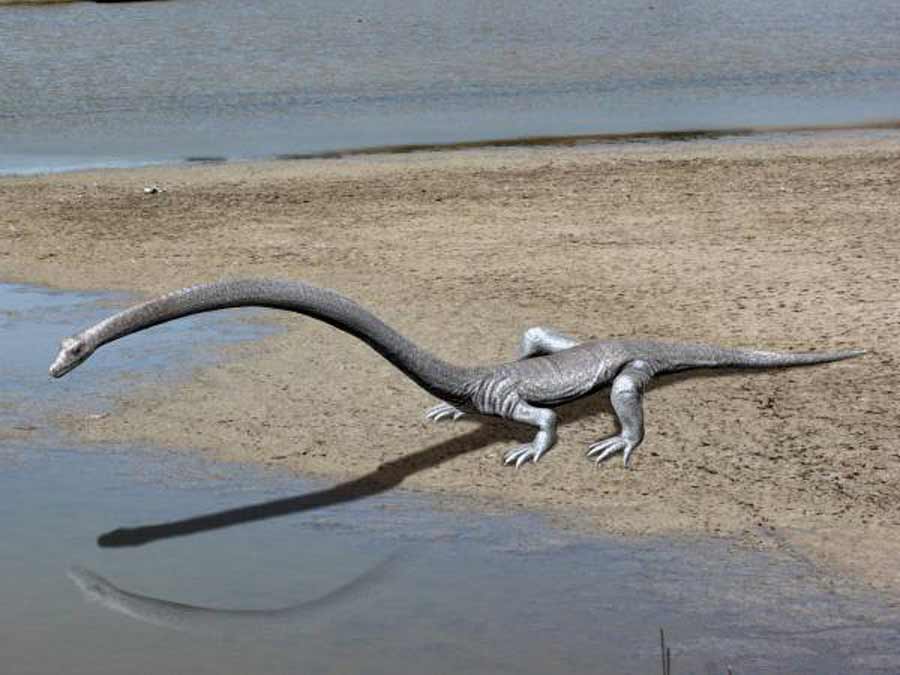

Since the first fossils of a reptile species called Tanystropheus were discovered in 1852, paleontologists have been attempting to discern how and where this unusual species lived.
Tanystropheus fossils have been dated to the Middle Triassic Period, which means the species existed between 245 and 230 million years ago. The largest specimens would have measured up to 16 feet (5 meters) long, from the tip of their tails to the ends of their snouts. Fossils of various sizes have been found, which paleontologists believed were from Tanystropheus specimens of different ages and maturity levels.

The fossil remains of a Tanystropheus dinosaur. (Ghedoghedo / CC BY-SA 3.0)
The Truth about Tanystropheus is Finally Revealed!
This reptile was an archosaur, like modern crocodiles and alligators, with similar torsos and limbs to those creatures. But unlike those animals, the Tanystropheus possessed an elongated neck that separated its head from the rest of its body by several feet, or up to two meters.
While the Tanystropheus had a neck like a giraffe, its body shape meant its neck would have been extended horizontally instead of vertically. This made it an anomaly, and this puzzled paleontologists who couldn’t say for sure whether it was a terrestrial or aquatic species (or some combination of both).
But much of the uncertainty has now been removed, thanks to research published in 2020 in the journal Current Biology. A team of paleontologists from Switzerland, the United States, Italy, and the United Kingdom has determined that there were actually two separate species of Tanystropheus living during the Triassic Period, at least one of which was equipped to survive quite comfortably full-time in a marine environment.
Because of its highly unusual shape and physical characteristics, it had previously been impossible for scientists to decide where Tanystropheus lived, or how it lived. An animal with a stout, squat crocodile’s body and a long, thin neck that comprised 40 percent of that body has no analogue in nature. The locations where fossilized remains have been discovered don’t provide answers, since the environments in those locations were radically different hundreds of millions of years ago.
To solve the mystery, the team of paleontologists turned to a type of CT scan known as high-resolution synchrotron radiation microtomography. They performed scans on a variety of fossil samples to create three-dimensional and highly-detailed models of different-sized Tanystropheus specimens.
“The power of CT scanning allows us to see details that are otherwise impossible to observe in fossils,” said Stephan Spiekman, a paleontologist from the University of Zurich and the lead author of the new Current Biology study.
One clear revelation to emerge from the CT studies was the fact that the smaller versions of Tanystropheus were neither adolescents nor children but were instead fully-grown members of a distinct Tanystropheus species. Telltale growth rings inside bones proved that the smaller specimens had finished maturing and had reached adulthood, even though they were much smaller in size than their counterparts with the six-foot-long (two-meter-long) necks.

A Tanystropheus hydroides underwater and ready to catch anything that came by. (Emma Finley-Jacob / University of Zurich)
Scientific Analysis Shows Both Species Had A Niche
Despite their similar overall appearance, the larger and smaller Tanystropheus species, labeled Tanystropheus hydroides and Tanystropheus longobardicus respectively, each filled their own niche within the same ecosystem.
Among the fossil samples the paleontologists scanned was a damaged skull that came from one of the larger types of Tanystropheus. Once it had been recreated in a more restored form, it offered new and vital information about Tanystropheus hydroides that cleared up much of the confusion about its living environment and lifestyle.
“From a strongly crushed skull we have been able to reconstruct an almost complete 3D skull, revealing crucial morphological details,” Spiekman explained.
Upon closer examination, the Tanystropheus hydroides skull revealed its secrets to the scientists, who knew they were looking at a creature that had evolved to live quite comfortably and naturally in marine environments.
The reptile’s nostrils were perched on top of its skull, just like they are on crocodile’s skull. This would have allowed the Tanystropheus hydroides to anchor itself to the floor of a shallow coastline, its body submerged but its head floating on the surface at the end of its elongated neck, taking in air while waiting for its prey to swim or walk by. Once fully underwater, Tanystropheus hydroides could snatch its waterborne prey in its mouth, relying on its dense and impressive assemblage of pointy teeth to act as a trap that would prevent escape.
“The small species likely fed on small shelled animals, like shrimp, in contrast to the fish and squid the large species ate,” said Spiekman.
Variations in dental architecture, which were discovered once the 3D-recreation of the larger skull was complete, allowed the paleontologists to make this determination. Since the smaller species didn’t possess vertically-placed nostrils, however, its methods for hunting and breathing while partially submerged would have differed somewhat from those of its larger cousin.

The two Tanystropheus dinosaur species: Tanystropheus hydroides (above) and Tanystropheus longobardicus (below). (Current Biology journal
The Surprising Adaptability of Nature and Paleontologists
The fact that two separate but closely related dinosaur species were able to survive in the same marine environment, each filling a unique niche, was one of the more surprising discoveries to emerge from this study.
“This is really remarkable, because we expected the bizarre neck of Tanystropheus to be specialized for a single task, like the neck of a giraffe,” Spiekman explained. “But actually, it allowed for several lifestyles. This completely changes the way we look at this animal.”
Rather than representing an oddity of nature, it seems the unusually long neck shared by both Tanystropheus species was a highly useful adaptation, perfectly appropriate for reptiles that needed to survive in the conditions that predominated in coastal environments during the long-lost Triassic Period.